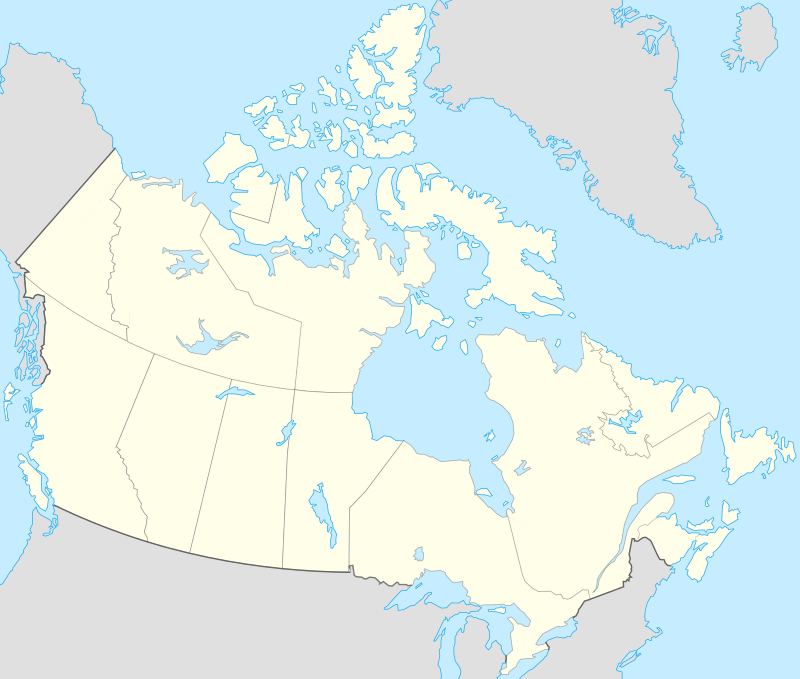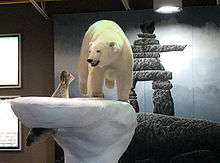Yellowknife Airport
Yellowknife Airport (IATA: YZF, ICAO: CYZF) is located in Yellowknife, Northwest Territories, Canada. The airport is part of the National Airports System, and is operated by the Government of the Northwest Territories. The airport has regular scheduled passenger service and a number of freight services. In 2007, the terminal handled 527,000 passengers.[6]
Yellowknife Airport Aéroport de Yellowknife[1] | |||||||||||||||
|---|---|---|---|---|---|---|---|---|---|---|---|---|---|---|---|
.jpg) | |||||||||||||||
| Summary | |||||||||||||||
| Airport type | Public | ||||||||||||||
| Owner/Operator | Government of the Northwest Territories[2] | ||||||||||||||
| Location | Yellowknife, Northwest Territories | ||||||||||||||
| Hub for | |||||||||||||||
| Time zone | MST (UTC−07:00) | ||||||||||||||
| • Summer (DST) | MDT (UTC−06:00) | ||||||||||||||
| Elevation AMSL | 675 ft / 206 m | ||||||||||||||
| Coordinates | 62°27′47″N 114°26′25″W | ||||||||||||||
| Website | www | ||||||||||||||
| Map | |||||||||||||||
 CYZF  CYZF | |||||||||||||||
| Runways | |||||||||||||||
| |||||||||||||||
| Statistics (2014) | |||||||||||||||
| |||||||||||||||
In 2008 the airport's passenger terminal underwent an expansion to the departure/check in section, roughly doubling the size of the terminal.[7] The airport is classified as an airport of entry by Nav Canada and is staffed by the Canada Border Services Agency (CBSA). CBSA officers at this airport can handle general aviation aircraft only, with no more than 15 passengers.[3]
The Royal Canadian Mounted Police (RCMP) "G" Division maintains a hangar for its air section just south of the passenger terminal. It is adjacent to a hangar used by the Royal Canadian Air Force (RCAF) to house the CC-138 Twin Otter and other utility aircraft operated by 440 Squadron, a subsidiary of 8 Wing.
Canadian NORAD Region Forward Operating Location Yellowknife is located south-west of the airstrip. It was built for forward deployment of the CF-18 Hornet in times of conflict.
Airlines and destinations
Passenger
| Airlines | Destinations |
|---|---|
| Air Canada Express | Calgary, Edmonton, Vancouver |
| Air North | Seasonal: Ottawa, Vancouver, Whitehorse |
| Air Tindi | Fort Simpson, Gamèti, Lutselk'e, Wekweètì, Whatì |
| Canadian North | Cambridge Bay, Edmonton, Fort Simpson, Gjoa Haven, Hay River, Inuvik, Iqaluit, Kugaaruk, Kugluktuk, Norman Wells, Rankin Inlet, Taloyoak, Ulukhaktok |
| Nolinor Aviation | Charter: Mary River |
| Northwestern Air | Fort Smith |
| North-Wright Airways | Déline, Norman Wells, Tulita |
| WestJet Encore | Calgary, Edmonton |
Cargo
| Airlines | Destinations |
|---|---|
| Buffalo Airways | Cambridge Bay, Déline, Fort Good Hope, Hay River, Kugluktuk, Norman Wells, Tulita |
Emergency services

The airport has its own fire and rescue service. The department has 10 firefighters, but requires only two or three fire fighters on shift to operate a single crash tender. Ambulance and additional fire response is provided by the Yellowknife Fire Department.[8]
See also
References
- "Aéroport de Yellowknife" (in French). Government of Northwest Territories. Retrieved 8 May 2019.
- Airport Divestiture Status Report
- Canada Flight Supplement. Effective 0901Z 16 July 2020 to 0901Z 10 September 2020.
- Synoptic/Metstat Station Information
- Total aircraft movements by class of operation — NAV CANADA towers
- Yellowknife Airport Development Plan Update Archived 2014-04-18 at the Wayback Machine
- Yellowknife Airport Expansion
- Aircraft Fire Fighting Services
External links

- Yellowknife Airport
- Entry about Yellowknife Airport on the Canadian Owners and Pilots Association's Places to Fly Airport Directory
- Past three hours METARs, SPECI and current TAFs for Yellowknife Airport from Nav Canada as available.